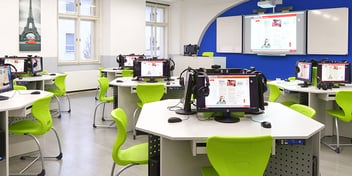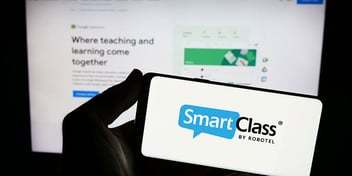
In a world where “globalization” and “cultural diversity” are becoming part of our daily lives, it...

A language lab is an environment that enables all students to practice their listening and speaking skills concurrently. Students can work individually and/or collaborate with their classmates in pairs, small groups, and full-class settings. Teachers can listen, observe and interact with their students.
1. What is a language lab?
2. Anatomy of a modern language lab
3. Why use a language lab?
4. Example activities for language labs
5. Conclusion
Merriam-Webster offers this broad definition of the word laboratory:
A place providing opportunity for experimentation, observation, or practice in a field of study.
From a language laboratory perspective, the keyword in this definition is practice. The more a student practices, the more proficient and more fluent he or she becomes in the target language.
And while 20th-century language labs typically used a dedicated room or traditional classroom (e.g., place), 21st-century digital language labs are more virtual in nature, employing technologies like WiFi, the cloud, tablets, smartphones, and BYOD (Bring Your Own Device).
So, perhaps a good working definition of a modern language lab might be:
A language lab is an environment that enables all students to practice their listening and speaking skills concurrently. Students can work individually and/or collaborate with their classmates in pairs, small groups, and full-class settings. Teachers can listen, observe and interact with their students.

Modern language labs – whether they are foreign language labs, world language labs, or second language labs (ESL labs) – typically include the following components:
TEACHER STATION – Teachers use a school-supplied computer-based workstation to manage language lab activities. The “computer” might be a simple laptop but it is often a desktop PC with a second monitor – used to display the language lab software console.
STUDENT STATIONS – Students can use any combination of school-supplied or personal:
• Desktop or laptop computers
• Tablets
• Smartphones
• Chromebooks
HEADSETS – Headsets help students focus on their own work by eliminating ambient room noises. Headsets also use noise-canceling directional microphones to ensure that students only record their own voices – and not those of neighboring students.
SERVER – A server is just a simple computer that hosts the language lab software and the database of multimedia assignments and student recordings and responses. The server can be hosted locally at the school or it can be entirely cloud-based.
NETWORK – Modern language lab software systems typically use the school’s data network to support communication and interaction among all participants. Networks can be wired or wireless (WiFi). Support for homework activities can also be extended across the Internet.
LANGUAGE LAB SOFTWARE – This is the software application that enables teachers and students to interact with one another. It includes a database of courses & classes and teacher & student participants, a library of multimedia lesson materials & assignments, and associated student responses & teacher feedback. This is the management system that integrates all of the component parts into a single learning platform.
 Studies have shown that for classes having more than 10 students, the average student is able to speak for less than one minute per hour of class time. Language Lab technology amplifies student practice by at least 10X, as all students are able to practice speaking concurrently. The path to fluency is practice, practice, and practice!
Studies have shown that for classes having more than 10 students, the average student is able to speak for less than one minute per hour of class time. Language Lab technology amplifies student practice by at least 10X, as all students are able to practice speaking concurrently. The path to fluency is practice, practice, and practice!
Additional benefits for teaching and learning include:
Benefits for teachers
a) Differentiation is made easy within the classroom
You can split the class into multiple sections and assign self-access activities to some students, while you work with a small group that needs review or a further challenge. It’s also easy to assign different activities to different students so that everyone can work on what they need to improve.
b) Keep students on task
You can record and listen in on conversations that students are having, as well as check their screens. While we would all like to believe that our students are there to learn the language, we also know how easily they can get distracted.
c) Simultaneous testing
Most official tests, such as AP testing or language proficiency tests (TOEFL/IELTS/TOEIC) include speaking or listening components. With a language lab, your students can all take the test at the same time.
d) Engage and motivate your students
Today’s students have grown up with the Internet, cell phones, and social media. Technology is comfortable and familiar to them and they are both engaged and motivated by using language learning technology.
Benefits for students
a) Motivation
Any meaningful use of hands-on technology in a classroom motivates students to participate and learn.
b) Self-confidence
Being able to practice pronunciation and receive instant feedback is one of the most valuable tools of a language lab. Students don’t need to be embarrassed anymore or worry about making mistakes in front of others.
c) Fluency
The possibilities for conversation activities within a language lab are endless. And with each of those activities, students will practice meaningful and authentic conversations, hence work on their fluency on a daily basis.
d) Collaboration and partnering
When working in groups or pairs, students can record their work and listen to it later. They are also able to get instant feedback from the teacher, who can listen to their conversations. For some students, being paired with another student over the computer/tablet/phone is less socially challenging and will motivate them to participate.
Most language labs support a blend of self-access and live activities. Self-access activities are assigned to the class often for homework. Each student works individually from any Internet-enabled location at any time. Live activities require that the teacher and all students meet concurrently, typically in the same location – or at least connected to the same Local Area Network (LAN).
Activity templates are provided for a broad range of reading, writing, listening, and speaking activities as well as quizzes and pronunciation. These templates can be used for grammar and vocabulary, for assessment, and for self-evaluation. Self-access activities are available 24/7 via an online resource known as the digital media library.


In the exercise shown below, students are given a set of phrases with which to work. By clicking on the Listen button, the student hears a model voice speak the selected phrase. By clicking on the Record button, the student can record himself speaking the same phrase.
The student’s recording is instantly forwarded to an Artificial Intelligence-enabled speech-recognition engine in the cloud. The student’s work is auto-graded by the software based on how well it matches the original.
This instant feedback is provided to the student when they are most receptive to receiving it and motivates them to immediately re-try the recording until they have achieved a good score.

Live activities include the following categories:

The teacher instructs all students to individually choose five of the following activities and put them anywhere on their schedule for next week:

Students are then given a scenario where they and their partner need to work on an essay, go to the movies, study for their final exam, and play soccer together next week. They must ask questions in the future tense to find out when their partner will be free.
If you are busy when your partner wants to meet, tell him/her what you’ll be doing at that time using the future conditional tense. When you find a time that’s free for both of you, add the activity to your schedule.
For example:
Partner 1: Will you be free on Thursday at 3:00 to work on our essay?
Partner 2: No, sorry, I’ll be marching in the parade. How about Monday at 9:00 a.m.?
Partner 1: I’ll be rock climbing. Will you be busy at 3:00 on Monday?
Partner 2: No, I’ll be free to work on our essay then.

Students are engaged and motivated when working in a familiar digital multimedia environment and therefore have a more positive learning experience.
The main benefit of a language lab is giving students more opportunities to practice their listening and speaking skills. The language lab can increase practice time by a minimum of 10X.
A 21st-century language lab rarely has a dedicated room, as it builds on technologies like the Internet, WiFi, the cloud, tablets, smartphones, and BYOD (Bring Your Own Device).
Modern digital language labs provide a blend of self-access and live activities that enable students to practice individually, in pairs, in groups, and/or as an entire class.
The pronunciation activity uses AI-based speech recognition to auto-grade the student’s work.


In a world where “globalization” and “cultural diversity” are becoming part of our daily lives, it...

Do you have colleagues who have been using SmartClass or other technology in their foreign language...

Teachers around the world have been working nonstop to continue teaching their students amid the...
Leave a comment